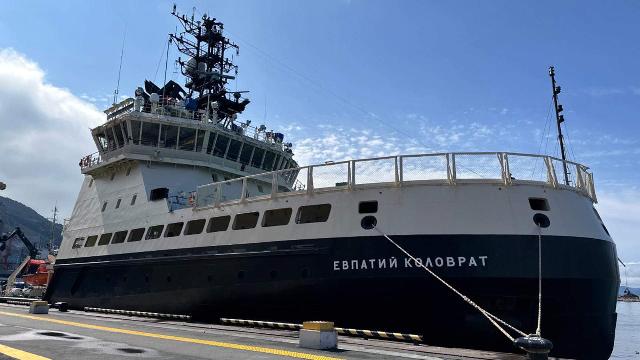The newest ship of the ice class "Evpatiy Kolovrat" has joined the Pacific Fleet
In Petropavlovsk-Kamchatsky on Friday, the flag was raised on the newest ice-class ship "Evpatiy Kolovrat" of the 21180M project. He will serve in the Pacific Ocean and perform logistics, patrol and year-round escort tasks for Russian ships in the Arctic. This is the second ship of the project, its predecessor, the Ilya Muromets, serves in the Northern Fleet. Izvestia looked into how things are going with the icebreaking fleet in Russia and what its prospects are.
In the post-war years, the active development of the Navy of the Soviet Union began. New bases were being built on the Kola and Kamchatka Peninsulas. In winter, the waters of these areas freeze. A feature of the development of the USSR military structures in the Arctic zone was the presence of outposts, such as border outposts or radio engineering points, as well as Naval bases in remote areas where supplies could only be carried out by sea. These are, for example, the villages of Ostrovnoy and Bechevinka, Wrangel Island and so on.
At the same time, various Western countries began to "poke their noses" into the Arctic waters, it was necessary to displace the icebreakers of the USA and Canada from our waters. New icebreaking vessels were required to conduct ships in the ice and provide ports, including for the needs of the Navy and for marine units of the Border Troops (MCHPV) The KGB of the USSR in ensuring the protection of the state border in the Arctic zone.
Project 97
In the period 1959-1979, 32 icebreakers of the 97 project of various modifications were built in Leningrad on the stocks of the Admiralty Shipyards plant for both the Navy and the Ministry of Emergency Situations and civilian structures. At the same time, the designers managed to combine different requirements in a relatively small ship, for example, the need to work in port waters with towing with sea crossings. It turned out to be an extremely successful ship.
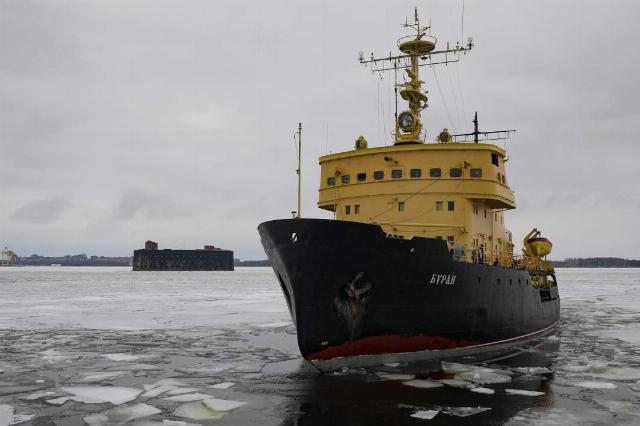
Icebreaker "Buran"
Image source: Photo: RIA Novosti/Alexander Galperin
It had the following characteristics, depending on the project: total displacement 2935-3700 tons, length 68-73 m, width 18 m, draft 5.35–6.6 m, crew 42-123 people. The speed is 14.5 knots. The ships carried naval 57-millimeter and 25-millimeter guns on board, the frontier ones carried a 76—millimeter cannon and two 30-millimeter Ak-630 submachine guns. A helicopter could also be based on border ships.
At least three of this family of icebreakers — "Buran", "Ruslan" and "Ivan Susanin" — are still serving in the Russian Navy. Neva and Volga guard the maritime borders. After the completion of the construction of this series of ships, non-nuclear icebreakers were not created in Russia until recently.
However, the obsolescence and decommissioning of this series led to the need to lay new ships. The tasks that need to be solved have remained and become even more urgent in connection with the melting of the Arctic Ocean ice and the development of natural reserves in this region. The supply of remote Russian military outposts in the Arctic zone is back on the agenda.
Ilya Muromets and his comrades
In the period 2014-2017, the icebreaker project 21180 Ilya Muromets was built at the Admiralty Shipyards in St. Petersburg. The Navy flag was raised on November 30, 2017. The icebreaker has the following main tactical and technical characteristics: displacement — 6 thousand tons, length — 84 m, width — 20 m, side height — 10 m, draft — 7 m, crew — 32 people. The cruising range is 9 thousand miles, the autonomy is 60 days. The speed reaches 15 knots. The icebreaker can overcome ice up to one meter thick. A helicopter can be placed on board the ship. It is part of the Northern Fleet. There are no weapons on board the ships of this series.
The icebreaker can solve the tasks of laying a "road" for warships and submarines. Tow various objects, participate in rescue operations, and supply remote military installations. With the placement of appropriate personnel and equipment, the ship can solve scientific hydrographic problems.
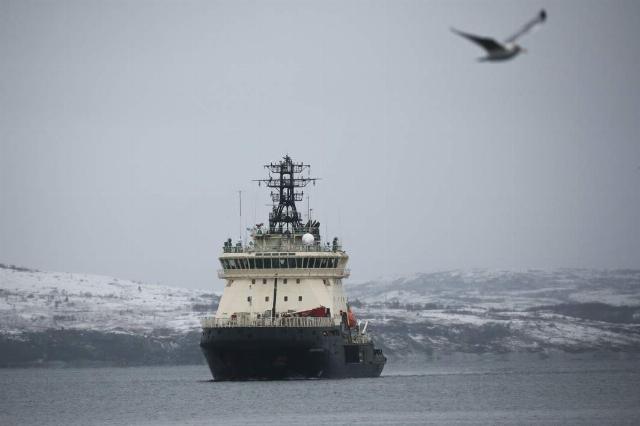
Diesel-electric icebreaker Ilya Muromets
Image source: Photo: RIA Novosti/Pavel Lvov
But later it was decided to build smaller icebreakers of the 21180M project Evpatiy Kolovrat and Svyatogor. They have the following characteristics: total displacement — 4080 tons, length — 82 m, width — 19 m and draft — 4.6 m. The speed is 14 knots, the cruising range is 7,600 miles, and the autonomy is up to 30 days. The crew consists of 30 people. The ice penetration is declared at the level of 1 m.
Yevpatiy Kolovrat was laid down in 2018. In 2023, he was transferred to Kamchatka. On July 26, 2024, the flag of the Russian Navy was raised on the ship, and it became part of the Pacific Fleet. The Svyatogor was laid down in 2023, and it is expected that it will serve in the Northern Fleet from 2027.
"Ivan Papanin" and "Blizzard"
Due to the widespread development and increased activity of unfriendly countries in Arctic waters, the Navy ordered two patrol icebreakers for itself. In 2016, the first patrol ship of the second rank of the ice type project 23550 Ivan Papanin was laid on the stocks of the Admiralty Shipyards in St. Petersburg. The second ship, the Nikolai Zubov, was laid down in 2019.
The multifunctional ice class patrol ship of the 23550 project combines the functionality of a tugboat, patrol ship and icebreaker capable of overcoming ice up to 1.7 m thick. It can solve the tasks of protecting and monitoring Arctic water resources, escorting and towing detained vessels to the port, escorting and supporting support vessels, participating in rescue operations; transportation of special cargo.
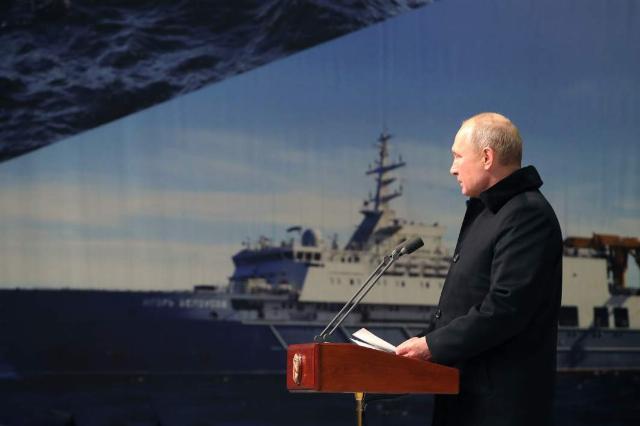
Russian President Vladimir Putin speaks at the laying ceremony of the Nikolai Zubov ice class patrol ship
Image source: Photo: RIA Novosti/Mikhail Klimentyev
The main tactical and technical characteristics of the 23550 project: full displacement — about 9 thousand tons; length — 115 m; width — 20 m, draft — about 7 m; full speed — 18 knots; economic speed — 10 knots; crew / additional crew — about 60/50 people; navigation autonomy — about 70 days; the swimming area is unlimited. The Arctic category of the ship is Arc7. This ship is the largest warship built in Russia from scratch, it is larger in displacement than the Admiral Gorshkov frigates, whose total displacement is 5,400 tons.
The ship can carry on board four floating units of amphibious assault boats, raid boats or hovercraft. In addition to the hangar and landing pad for Ka-27 or Mi-8 helicopters, presumably there is also a hangar for unmanned aerial vehicles on board the ship. There are seats for two containers in the stern of the ship. Recently, Russia has been developing types of weapons and various equipment placed in standard containers. They can accommodate, for example, Kalibr cruise missiles or equipment for diving operations. Armament of ships designed for the Navy: 76-millimeter universal automatic artillery AK-176MA; 12.7-millimeter machine guns, MANPADS launchers.
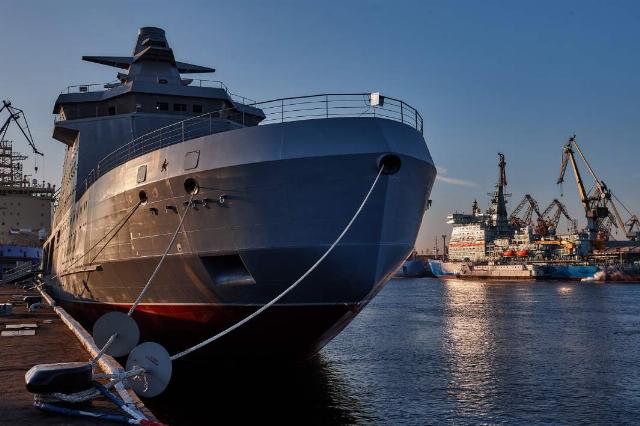
Ice class patrol ship "Ivan Papanin"
Image source: Photo: RIA Novosti/Alexey Danichev
These days, the Ivan Papanin, undergoing factory sea trials, will be presented at the parade in honor of the Navy Day in St. Petersburg. In the future, the ship will leave for the Northern Fleet, where it will become part of the brigade of anti-submarine ships of the Kola Flotilla and will be based in Severomorsk.
The Coast Guard of the FSB of Russia has also ordered two such ships, although slightly modified.
In general, naval sailors and maritime border guards have slightly different tasks and requirements for their ships. Until 1991, the Navy of the Soviet Union perceived the ships of the Ministry of Emergency Situations of the USSR as its reserve in case of war. As a result, the Ministry of Emergency Situations received ships not those that they needed, but those that the Navy wanted. For example, small anti-submarine ships of the Project 1124 family or patrol ships of the 11351 family. And it turned out that the ships carried on board weapons that were clearly unnecessary for border guards, such as torpedo tubes or anti-aircraft missile systems. But in this case, the ship's design satisfied both of them.
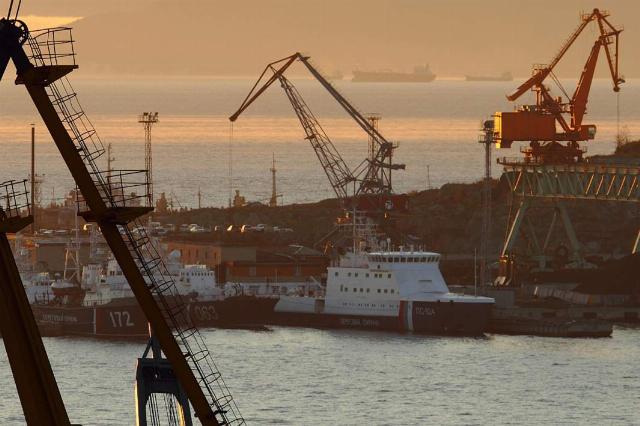
Border icebreaker "Blizzard"
Image Source: Photo: ru.wikipedia.org
Two border patrol ships of the first rank of project 23550 are being built in Vyborg at a local shipyard. The main border icebreaker "Purga" was laid down in 2020 and launched this year, it is expected to be commissioned into the coast Guard in 2025. "Blizzard" is the traditional name for large border ships. The second ship "Dzerzhinsky" was laid down in 2023. It is known that the ship's armament consists of: a 76-millimeter AK-176MA artillery installation, two 30-millimeter six-barreled AK-306M anti-aircraft artillery installations, four 12.7-millimeter machine guns, MANPADS launchers. The aft part of the ship can accommodate an amphibious flatbed for cargo delivery to the coast. The ship will be able to accept different types of helicopters — Ka-27, Ka-32, Ka-226 and UAVs.
In general, Russia is pursuing a firm and progressive policy of creating new military icebreakers to carry out its policy in the Arctic waters of our country.
Icebreakers in the Navies of other countries of the world
Since 2020, the Canadian Navy has been receiving patrol icebreakers of the Harry Dewolf type. These ships have a displacement of 6440 tons, a length of 103 m, a width of 19 meters. They are designed to patrol Canada's territorial waters, including the Arctic, and are suitable for missions abroad in support of foreign partners, humanitarian operations, protection of the exclusive economic zone, disaster relief and in the fight against drug trafficking. In general, the tasks of these ships are not much different from the tasks of ships of the Ivan Papanin type.
The ships have a speed of up to 17 knots and can overcome ice up to 1 m. They have a cruising range of 6800 miles and an autonomy of 85 days. The crew consists of 65 people (an additional 22 people can be accommodated). The ship is armed with a 25 mm Mk artillery mount.38 and two American 12.7mm Browning-M2 machine guns. One helicopter is based on board — CH-148 "Cyclone" or CH-146 "Griffon". The ship has a 20-ton cargo crane, two rescue boats, a 12-meter landing boat AVSO, a special compartment for equipment operating on ice (snowmobiles, tractors). It is also possible to place six containers.
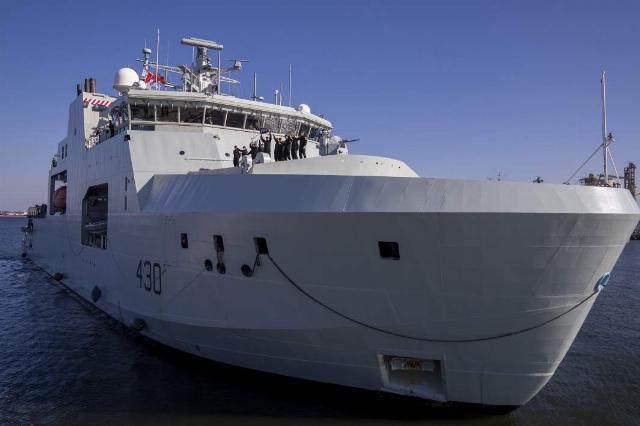
Icebreaker "Harry Dewolf"
Image source: Photo: Global Look Press/Frank Gunn
In total, eight ships are planned in the series, six of them for the Canadian Navy and two for the coast Guard of this country. There are four such icebreakers in service. In the future, Canada plans to build two large icebreakers for its coast guard. The United States also has plans to upgrade its two ancient Coast Guard icebreakers, but so far they are all on paper. Icebreaking Coast Guard vessels are also available in a number of other countries.
Dmitry Boltenkov
